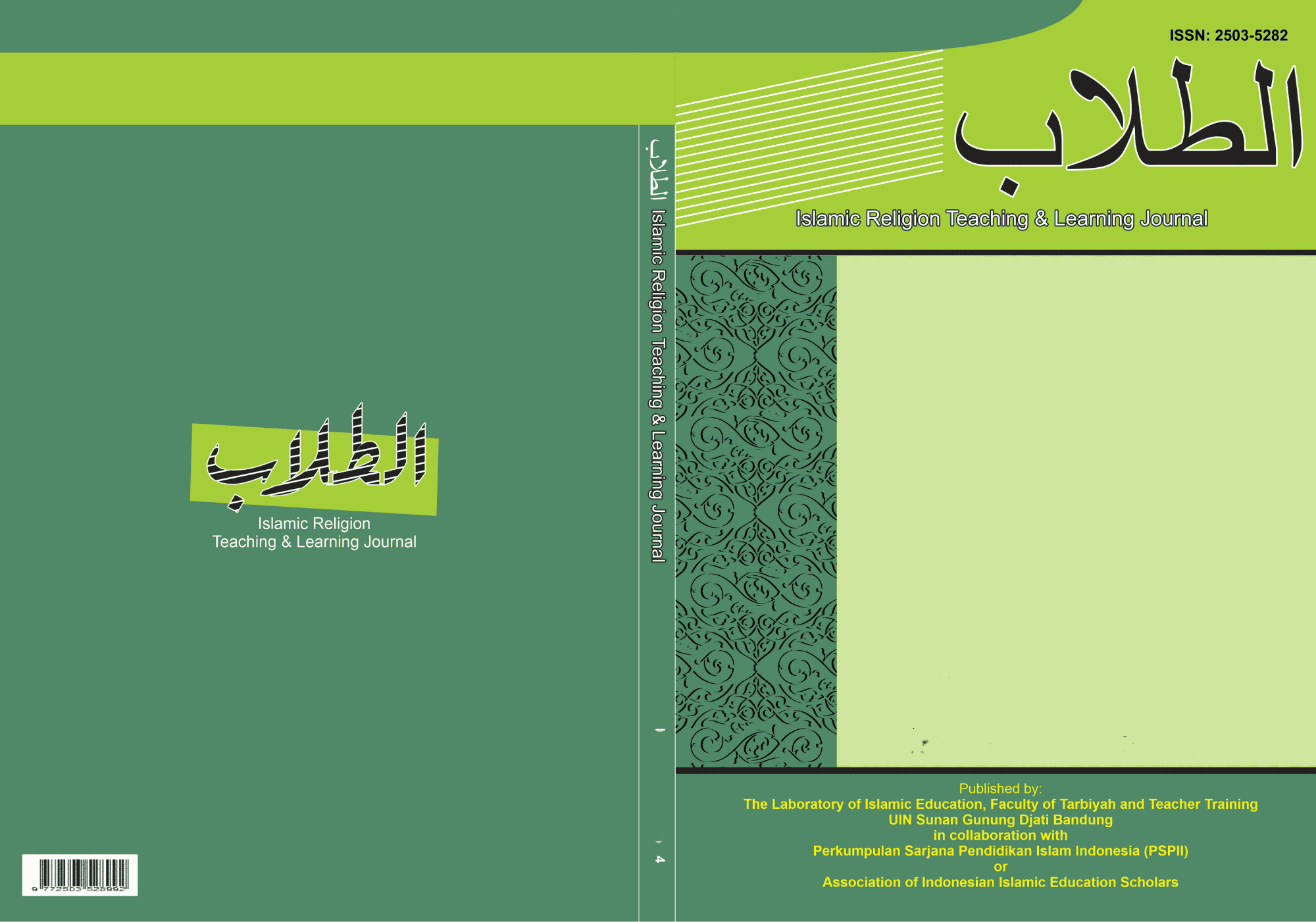Fostering Interreligious Harmony in Thailand: Insight from a Thai Islamic School
DOI:
https://doi.org/10.15575/ath.v9i1.30019Keywords:
Harmony, Interreligious, Thai Islamic SchoolAbstract
The purpose of this research is to explore aspects of culture and social structure, the tools used to promote coexistence, and the collaboration between the Muslim and Buddhist communities. In the context of Thailand, pluralism, or religious and cultural diversity, plays a crucial role as it can be a potential source of conflict. One form of conflict that has arisen is the tension between the Pattani Muslim community and the Buddhist population in Thailand. However, the role of Islamic education there has a significant impact on fostering interreligious harmony. Through 26 days of participatory observation at Ar-Rabity Technological College in Thailand, this research successfully revealed that Thai society holds strong nationalistic sentiments, values religious diversity, and places a high importance on social hierarchy. Furthermore, various strategies have been employed to maintain harmony in Thailand, such as multicultural education, instilling tolerance values from an early age, and organizing cross-cultural communication seminars. Through these efforts, it is hoped that a more inclusive and harmonious environment can be cultivated amidst the religious and cultural diversity present in Thailand.
Tujuan penelitian ini untuk menjelajahi aspek budaya dan struktur sosial, alat-alat yang digunakan untuk mempromosikan kerukunan, serta kolaborasi antara komunitas Muslim dan Buddha. Dalam konteks Thailand, pluralitas atau keberagaman agama dan budaya memiliki peran krusial karena dapat menjadi pemicu konflik. Salah satu bentuk konflik yang muncul adalah pertentangan antara umat Muslim Pattani dan umat Buddha Thailand. Namun, peran pendidikan Islam di sana memiliki pengaruh yang signifikan dalam merawat kerukunan antaragama. Melalui partisipasi aktif selama 26 hari di Ar-Rabity Technological College Thailand, penelitian ini berhasil mengungkapkan bahwa masyarakat Thailand memiliki rasa nasionalisme yang kuat, menghargai keragaman agama, dan memperhatikan hierarki sosial yang sangat penting. Selain itu, untuk menjaga kerukunan di Thailand, berbagai strategi telah digunakan, seperti pendidikan multikultural, penanaman nilai-nilai toleransi sejak usia dini, dan penyelenggaraan seminar komunikasi lintas budaya. Melalui upaya-upaya ini, diharapkan dapat membentuk lingkungan yang lebih inklusif dan harmonis di tengah keberagaman agama dan budaya yang ada di Thailand.
References
Abu Bakar Kabakoran, dkk. (2017). Kajian Historis Gerakan Islam di Pattani Thailand Selatan (Pertama). LP2M IAIN Ambon. Retrived From http://repository.iainambon.ac.id/2373/1/Kajian%20Historis%20Gerakan%20Islam%20di%20Pattani%20Thailand%20Selatan.pdf
AL-RISALAH, M. Y.-, & 2019, undefined. (n.d.). Kurikulum Pendidikan Islam di Thailand dan Brunei Darussalam (Kajian Pada Jenjang Pendidikan Pesantren). Jurnal.Stairakha-Amuntai.Ac.Id. Retrived From https://jurnalstairakha.com/index.php/alris/article/view/54/45
Alfi dan Dedi. (2020). Komunikasi Lintas Budaya Dalam Proses Belajar Bahasa Inggris di Kampung Inggris Pare Kediri. E-Procceding of Management, 7. https://doi.org/10.21009/COMMUNICOLOGY.14.01
Andrea Lidwina. (2021). 10 Negara Paling Dermawan di Dunia.
Aprin Rodiyah. (2023). Profil Sekolah Ar-Rabity Technological College.
Ardhani, D., Agusti, L., Edukatif, A. Z.-J. I., & 2020, undefined. (n.d.). Merawat Kerukunan Beragama pada era 4.0. Journal.Iaisambas.Ac.Id, 1(2020). https://doi.org/10.37567/jie.v6i1.106
Arphattananon, T. (2018). Multicultural education in Thailand. Intercultural Education, 29(2), 149–162. https://doi.org/10.1080/14675986.2018.1430020
Aslan dan Hifza. (2020). Dinamika Pendidikan Islam di Thailand Pada Abad 19-20. Nazhruna: Jurnal Pendidikan Islam, 3. https://doi.org/10.31538/nzh.v3i1.476
Budaya dan Akar Gerakan Separatisme, P., & Rudolf Yuniarto, P. (2005). Minoritas Muslim Thailand Asimilasi, Perlawanan Budaya dan Akar Gerakan Separatisme. Jmb.Lipi.Go.Id, 7(1). Retrived From https://jmb.lipi.go.id/index.php/jmb/article/download/213/193
Celly Beto. (n.d.). Membangun Budaya Antri Belajar Dari Thailand.
Che Man, W. K. (1990). The Thai Government and Islamic Institutions in the Four Southern Muslim Provinces of Thailand. Journal of Social Issues in Southeast Asia, 5(2), 255–282. https://doi.org/10.1355/sj5-2d
Di, I., Rusli, T., Tarbiyah, F., Keguruan, D., Sejarah, J., & Islam, K. (n.d.). Islam Di Thailand. Rjfahuinib.Org. https://doi.org/10.15548/khazanah.v0i0.70
eDiplomat. (n.d.). Thailand. 2023.
Ervan Hardoko. (2018). Kejujuran Seorang Sopir Taksi Bangkok Thailand Kembalikan Rp 146 Juta Milik Penumpang.
Hak, P., Idaman, I., Sejarah, M. M.-J. P. P., & 2022, undefined. (2022). Artikel STRATEGI MERAWAT KERUKUNAN UMAT BERAGAMA DI KOTA KENDARI: Merawat Kerukunan Umat Beragama di Kota Kendari. Jpps.Uho.Ac.Id. https://doi.org/10.36709/jpps.v7i4.6
Heri Akhmadi. (2018). Mengenal Kultur dan Karakter Orang Thailand, Pelajaran Dari #Thailandcaverescue.
Hermansyah, R., Amaliya, F., … M. N.-J. of C., & 2022, undefined. (2018). Peran Agama Islam Untuk Mewujudkan Kerukunan di Lingkungan Masyarakat. Jocosae.Org, 4(2). Retrived From http://jocosae.org/index.php/jocosae/article/download/75/53
Hull, J. M. (2021). The Contribution of Religious Education to Religious Freedom: A Global Perspective. In Religious Education in Schools: Ä°deas and Experiences around the World. IRARF, Oxford. https://iarf.net/REBooklet/Hull.htm.
Ilyasin, M., Baharun, H., Java, E., & Java, E. (2020). Multicultural Education In A Religious Life : Developing Harmony Among Religions In Southeast Asia. 3791–3801. Retrived From https://risbang.unuja.ac.id/media/arsip/berkas_prosiding/744.pdf
Islam, B. K.-H. J. B. dan K., & 2016, undefined. (n.d.). Masyarakat Muslim Thailand dan Dampak Psikologis Kebijakan Asimilasi Budaya. Digilib.Uin-Suka.Ac.Id.
Islam, S. S.-T. J. S., & 2018, undefined. (n.d.). Islam Di Thailand. E-Jurnal.Iainsorong.Ac.Id.
Jalaluddin Assayuthi. (2020). Urgensi Pembelajaran Pendidikan Agama Islam Multikultural. ATTHULAB: Islamic Religion Teaching & Learning Journal, 5(2), 24–254.
Kerukunan Umat Beragama Berbasis Kearifan Lokal di Manokwari Papua Barat -Muhammad Sadli Mustafa, M., & Sadli Mustafa Peneliti Balai Litbang Agama Makassar, M. (n.d.). Merawat Kerukunan Umat Beragama Berbasis Kearifan Lokal di Manokwari Papua Barat. Jurnalalqalam.or.Id.
Man, W. K. C. (1990). The Thai Government and Islamic Institutions in the Four Southern Muslim Provinces of Thailand. Sojourn: Journal of Social Issues in Southeast Asia, 5(2), 255–282. https://doi.org/10.1355/sj5-2d
Mod. (n.d.). Video: When and How to Wai Properly. 2013.
Muhtadi, A. S. (2019). Komunikasi Lintas Agama : Mencari Solusi Konflik Agama.
Muna, N. (2020). Konsep Kerukunan Pada Aliran Kerohanian Sapta Darma Perspektif Teori Kohesivitas Kelompok. Retrived From https://etheses.iainkediri.ac.id/2772/2/933415116%20bab1.pdf
Muslim Basrowi. (2019). Peradaban Thailand (Yulianawati (ed.)). ALPRIN.
Pendi Susanto. (2015). Perbandingan Pendidikan Islam di Asia Tenggara. Jurnal Pendidikan Islam, IV. DOI : 10.14421/jpi.2015.41.71-93
Purwanto, Y. dan E. (2022). Pendidikan Islam di Thailand. Educational Journal: Generan and Spesific Research, 2(1), 51–61. Retrived From https://adisampublisher.org/index.php/edu/article/download/64/58
Rahman, R., Kawakib, I. M.-J., & 2020, undefined. (n.d.). Pendidikan Islam Di Thailand. Kawakib.Ppj.Unp.Ac.Id.
Rasyid, R., Natsir, T., & Anwar, B. (2021). Survey kohesivitas kelompok guru SMKN 3 Makassar. Retrived From https://eprints.unm.ac.id/31769/1/21.1.%20Artikel_Survey%20Kohesivitas%20Kelompok.pdf
Razvi, M. (1979). Thai Muslims. Pakistan Horizon, 32(3), 59-66.
Samrin. (2016). Pendidikan Karakter (Sebuah Pendekatan Nilai). Jurnal Al-Ta’dib, 9(1), 122–123. https://dx.doi.org/10.31332/atdb.v9i1.505
Selçuk, M. (1997). Din Öğretiminin Kuramsal Temelleri: Zihin Gelişimi Açısından Bir Deneme. Din Eğitimi Araştırmaları Dergisi, 4, 145–158. Retrived From https://www.kuranveinsaninanlamarayisi.com/FileUpload/op492780/File/din_ogretiminin_kuramsal_temelleri.pdf
Society, N. N.-J. of G. and C., & 2017, undefined. (n.d.). Kerukunan dan toleransi antar umat beragama dalam membangun keutuhan negara kesatuan republik Indonesia (NKRI). Jurnal.Umt.Ac.Id.
Suhrke, A. (1977). Loyalists and Separatists: The Muslims in Southern Thailand. Asian Survey, 17(3), 237–250. https://doi.org/10.2307/2643498
Syakhrani, A. W. (2022). Pendidikan Agama Islam di Thailand. Adiba: Journal of Education, 2(1), 74–79. Retrived From https://adisampublisher.org/index.php/adiba/article/download/58/52
Syarip Ahmad D. (2023). 10 Kebiasaan Orang Thailand yang Membuat Wisatawan Heran.
W. Gulo. (2017). Metodologi Penelitian. Grasindo.
Wayeekao, N. (2016). Berislam dan Bernegara bagi Muslim Patani : Perspektif Politik Profetik. In Right: Jurnal Agama Dan Hak Asasi Manusia, 5(2), 1–55. Retrived From https://core.ac.uk/download/pdf/229718628.pdf
World Bank. (n.d.). Populasi Thailand saat ini. 2023.
Yumetri Abidin. (2020). Pengantar Budaya Masyarakat Asia Tenggara. Lembaga Penerbitan UNAS. Retrived From http://repository.unas.ac.id/2330/1/Cover%20ASEAN%20isi%20lengkap.pdf
Zuchri Abdussamad. (2021). Metode Penelitian Kualitatif. In Syakir Media Press.
Downloads
Published
How to Cite
Issue
Section
License
Authors who publish with this journal agree to the following terms:
- Authors retain copyright and grant the journal right of first publication with the work simultaneously licensed under a Creative Commons Attribution-ShareAlike License that allows others to share the work with an acknowledgement of the work's authorship and initial publication in this journal.
- Authors are able to enter into separate, additional contractual arrangements for the non-exclusive distribution of the journal's published version of the work (e.g., post it to an institutional repository or publish it in a book), with an acknowledgement of its initial publication in this journal.
- Authors are permitted and encouraged to post their work online (e.g., in institutional repositories or on their website) prior to and during the submission process, as it can lead to productive exchanges, as well as earlier and greater citation of published work (See The Effect of Open Access).






